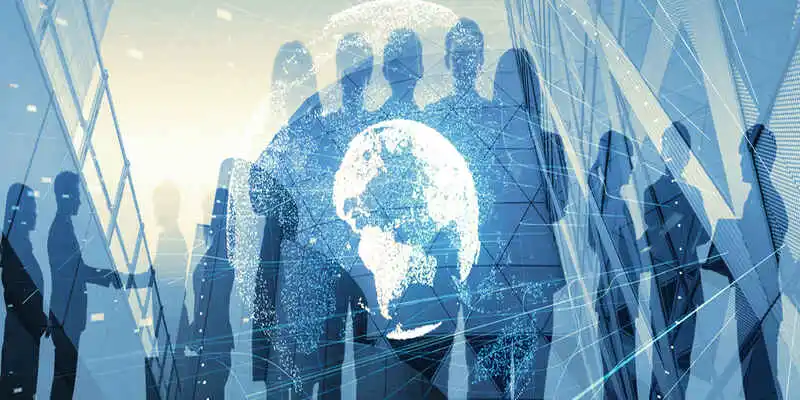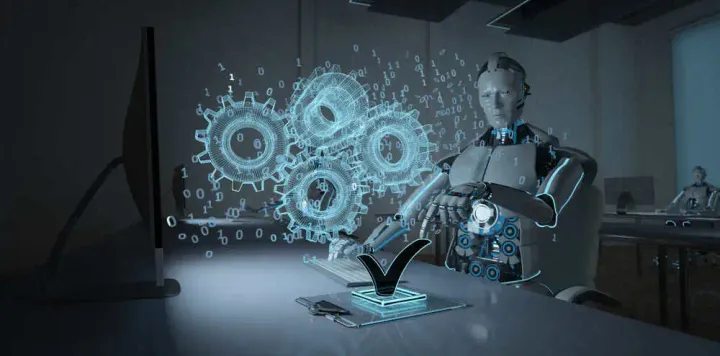A Beginner’s Guide to Understand Artificial Intelligence (AI)
Artificial Intelligence (AI) is no more a futurisitc term. This revolutionary technology has transformed how we live and work, simplifying tasks and solving complex problems. Let's breaks down AI, discuss its core concepts, real-world uses, and the ethical dilemmas it presents for society.

Artificial Intelligence (AI) is no longer just a futuristic notion; it's a current reality that's reshaping how we live and work. AI can simplify everyday tasks, transform business models, and offer new ways to solve complex problems. But what exactly is AI, and why does it matter to us all? This article breaks down AI into understandable segments, discusses its applications, and addresses the ethical dimensions and societal impacts.
What is Artificial Intelligence?
Artificial Intelligence involves creating computer systems that can perform tasks that typically require human intelligence. These tasks include reasoning, learning from past experiences, making sense of complex data, recognizing patterns, understanding languages, and making decisions. AI mimics human cognition to manage information and create outputs that would normally depend on human intervention.
To better understand the landscape of Artificial Intelligence, it's essential to know the different types or categories into which AI systems can be classified. These categories help us grasp the capabilities and potential of AI technologies across various applications. Here are the three primary types of AI:
- Artificial Narrow Intelligence (ANI), also known as Weak AI, is designed to perform a narrow task such as facial recognition, internet searches, or driving a car. It operates under a limited set of constraints and limitations. For instance, voice assistants like Amazon’s Alexa and Apple’s Siri are tailored to perform specific tasks such as answering questions, playing music, or controlling smart devices within your home. Similarly, image recognition software is utilized in applications ranging from scanning digital images in radiology to tagging friends on social media platforms.
- Artificial General Intelligence (AGI), or Strong AI, refers to a type of AI that can understand, learn, and apply intellectual abilities across a wide range of tasks, matching or surpassing human intelligence. AGI can think, understand, and act in a way that is indistinguishable from that of a human in any given situation. However, AGI remains more of a theoretical concept than a reality at this point. No existing AI systems have achieved true AGI capability, as this would require an AI to possess comprehensive cognitive abilities including reasoning, problem-solving, and planning.
- Artificial Superintelligence (ASI) represents an AI that surpasses human intelligence across all aspects—from creativity and social skills to general wisdom and problem-solving capabilities. Like AGI, ASI remains a hypothetical scenario. It refers to a future where AI’s cognitive ability is superior to human intelligence in every conceivable way. Discussions around ASI often involve ethical and existential risks and considerations.
How Does AI Work?
Artificial Intelligence operates through a combination of data, algorithms, and computing power to simulate human intelligence processes. Let's explore these components in more detail to understand how AI systems learn and function effectively.
Data: The Foundation of AI
AI systems require data to learn and make decisions. This data can come in various forms, such as text, images, and videos, or more complex data types like sensor data from machines. The quality and quantity of the data greatly influence the performance of AI systems. For instance, an AI model designed to recognize dogs in photographs needs thousands of images of dogs in various poses and environments to learn effectively. The more data it processes, the better it becomes at recognizing dogs, even in new pictures it hasn't seen before.
Algorithms: The Brains Behind AI
At the heart of AI are algorithms, which are sets of rules and instructions that tell the AI system how to interpret data and learn from it. These algorithms adjust and improve over time through a process called machine learning. A common example is the recommendation algorithms used by streaming services like Netflix or YouTube. These algorithms analyze your viewing history and compare it with data from millions of other users to recommend shows or videos you might like. As you watch more content, the recommendations become more tailored to your preferences.
Machine Learning: AI's Learning Process
Machine learning is a subset of AI that allows systems to automatically improve through experience. It involves training an AI model using large amounts of data. There are several types of machine learning:
- Supervised Learning: This method involves training the AI with data that is already labeled. For example, in spam detection, the AI is trained on a dataset of emails that are labeled as 'spam' or 'not spam.' The AI learns to recognize patterns in the data that indicate spam and can then apply this knowledge to new, unlabeled emails.
- Unsupervised Learning: Here, the AI is given data without explicit instructions on what to do with it. The system tries to learn the patterns and structure from the data itself. A common application is market segmentation, where AI analyzes customer data and groups customers with similar behaviors or preferences together without prior labeling.
- Reinforcement Learning: In this approach, the AI learns through trial and error, using feedback from its actions to learn over time. A famous example is AlphaGo, an AI developed by DeepMind that learned to play the board game Go. AlphaGo played millions of games against itself, gradually learning which strategies led to victory and which did not.
- Computing Power: The final piece of the puzzle is computing power. Advanced AI applications require substantial computational resources to process data and run algorithms effectively. This is especially true for tasks involving large datasets or complex models, such as training AI to drive cars autonomously. These tasks require thousands of hours of video and sensor data from real driving conditions, and processing this data requires powerful processors and sometimes specialized hardware like GPUs (Graphics Processing Units).
Examples of AI in Everyday Life
Artificial Intelligence has become an integral part of daily activities, often without us even realizing it. Here are additional examples of how AI impacts our lives on a day-to-day basis:
1. Personal Assistants
Virtual personal assistants like Siri, Google Assistant, and Alexa are powered by AI. They use natural language processing and machine learning to understand and respond to voice commands. Whether it's setting reminders, playing music, controlling smart home devices, or getting weather updates, these assistants make daily tasks more convenient.
2. Recommendation Systems
AI drives the recommendation engines on platforms like Netflix, Amazon, and Spotify. By analyzing your past behavior, preferences, and even comparing them to similar users, AI algorithms suggest movies, products, or music tailored to your tastes. This not only enhances the user experience but also increases the likelihood of consumption.
3. Smart Home Devices
AI is increasingly used in home automation through smart home devices such as thermostats, security cameras, and lighting systems. For example, Nest thermostats learn your schedule and temperature preferences to adjust your home's heating and cooling automatically. Similarly, security cameras like those from Ring use AI to recognize familiar faces and alert homeowners about unusual activities. Check out our list of best AI cameras for enhanced security.
4. Banking and Finance
AI helps detect fraudulent transactions in banking and finance by analyzing patterns that deviate from the norm. When a potentially fraudulent transaction is detected, the system can alert the bank and the customer, thereby preventing possible financial loss. Additionally, many banks use chatbots to provide 24/7 customer service, handling inquiries about account balances, recent transactions, and even processing payments.
5. Social Media
Social media platforms use AI to personalize what you see in your feeds. From Facebook to Instagram, AI algorithms analyze your interactions (likes, shares, and comments) to curate content that keeps you engaged on the platform. AI is also used to detect and filter out inappropriate content, although this is an area requiring ongoing improvement.
6. E-Commerce
AI enhances the online shopping experience by providing personalized shopping experiences. For example, AI can suggest products you might like based on your browsing and purchase history. This technology also helps manage inventory and optimize logistics for faster delivery times.
7. Traffic and Navigation
AI is utilized in traffic management (including air traffic) and navigation through apps like Google Maps and Waze. These apps analyze real-time traffic data to offer the fastest routes to drivers and predict traffic conditions. This not only saves time but also helps reduce congestion and emissions.
8. Health and Fitness Apps
Many fitness apps use AI to analyze your physical activity and provide recommendations tailored to your fitness goals. These apps can track progress over time and adjust your exercise regimen accordingly. Wearable devices that monitor heart rate and activity levels also use AI to provide insights into your health and fitness.
9. Language Translation
Real-time language translation tools such as Google Translate and M2M-100 by Meta use AI to break down language barriers. These tools use deep learning models to improve translation accuracy and provide translations in a conversational tone, making interactions in different languages more accessible and natural.
10. Autonomous Vehicles
Although still in advanced testing phases, autonomous vehicles use AI to navigate safely. These vehicles process vast amounts of sensor data to make real-time decisions about speed, direction, and when to apply brakes, promising future impacts on personal and public transportation.
Current Advancements in AI
The field of Artificial Intelligence has been rapidly evolving, with significant advancements and discoveries across various sectors. Below, we delve deeper into some of these key areas, highlighting notable achievements and the impact they're having.
Healthcare
AI's integration into healthcare is revolutionizing how we diagnose, treat, and manage diseases:
1) Disease Prediction and Diagnosis
- Cancer Detection: AI systems, like those developed by Google Health, have been trained to detect breast cancer from mammography images with a level of accuracy comparable to, and sometimes surpassing, human radiologists. A study published in Nature in 2020 highlighted an AI model that showed a reduction in false negatives by 9.4% and false positives by 5.7% in the U.S. population tested.
- Heart Disease Prediction: Researchers at the University of Nottingham developed an AI system that predicts the risk of a patient having a heart attack more accurately than traditional medical methods. This system, detailed in a 2017 PLOS ONE journal article, analyzes the medical data of patients to forecast cardiovascular risk with significantly higher accuracy.
2) Personalized Medicine
- Treatment Customization: AI is being used to tailor treatments to individual patients based on their unique genetic makeup and health history. A notable example is IBM Watson's application in oncology, where it assists in creating personalized treatment plans by analyzing the medical literature and clinical information.
Automotive
AI in the automotive industry is focusing on improving safety and creating autonomous driving systems:
1) Autonomous Vehicles
-
Companies like Tesla, Waymo, and Uber are advancing the development of self-driving cars. These vehicles use AI to process data from vehicle sensors and make split-second decisions that can help avoid accidents and improve traffic efficiency.
-
Enhanced Navigation Systems: AI is used to analyze traffic data in real time, helping to optimize routes, reduce traffic congestion, and improve overall transportation efficiency.
2) Safety Features
- Predictive Maintenance: AI-powered tools predict when parts of a car need maintenance before they fail, reducing the risk of accidents and breakdowns. For instance, companies like BMW and General Motors use AI to monitor vehicle health and notify owners of potential issues before they become serious problems.
Finance
AI in finance is transforming how we interact with money, from automated trading to fraud prevention:
1) High-frequency Trading (HFT)
AI algorithms are used to execute thousands of orders at lightning speeds—much faster than any human could. These systems analyze market data to execute trades at optimal times, improving profitability.
2) Fraud Detection
Banks and financial institutions use AI to detect unusual patterns in behavior that could indicate fraudulent activities. For example, Mastercard uses AI-driven systems to analyze transaction data in real time to detect and prevent fraud.
Technology and Communications
AI is also making significant strides in improving our interaction with devices and enhancing connectivity:
1) Smart Assistants
Virtual assistants like Amazon’s Alexa, Apple's Siri, and Google Assistant use natural language processing (NLP) to understand and respond to user requests, making everyday tasks easier through voice commands.
2) Enhanced Connectivity
AI is used in managing and optimizing networks, including the deployment of 5G, where AI algorithms help predict network anomalies and secure data transmission.
Pros and Cons of Artificial Intelligence
Artificial Intelligence offers a range of benefits and introduces some risks, influencing multiple sectors from healthcare to manufacturing. Understanding these advantages and disadvantages helps in assessing how AI impacts our lives and work.
Pros of AI
1. Increased Efficiency
AI systems can process and analyze data much faster than humans, which can lead to more efficient decision-making. For example, AI in logistics can optimize routes in real-time, significantly reducing delivery times and fuel consumption.
2. Precision and Accuracy
AI applications in fields like medicine can analyze vast databases of health information to assist with diagnosis and treatment plans. In radiology, AI algorithms enhance the precision of reading X-rays and MRIs, often spotting subtle cues that human eyes might miss.
3. Cost Reduction
By automating routine tasks, AI can significantly reduce labor costs and increase productivity. For example, in manufacturing, AI-driven robots can perform repetitive tasks 24/7 without breaks, reducing the need for human labor and minimizing human error.
4. Handling Hazardous Work
AI robots can perform dangerous tasks, such as defusing bombs, working in toxic environments, or handling heavy machinery, which reduces the risk to human life. For instance, drones are used for inspecting pipelines and other infrastructure in hazardous conditions, ensuring human safety.
5. Accessibility Improvements
AI technology can help people with disabilities by providing them with tools that improve communication. For example, AI-powered applications like voice recognition technologies enable individuals who have difficulties with mobility or dexterity to interact with digital devices more easily.
6. Data-Driven Insights
In business, AI can sift through big data to find patterns and insights that humans might overlook. These insights can help companies predict market trends, understand customer preferences, and make informed strategic decisions.
Cons of AI
1. Job Displacement
As AI automates more tasks, it can lead to job displacement, especially in industries that rely heavily on routine jobs. For instance, the introduction of self-checkout machines and online customer service chatbots has reduced the number of retail and customer service jobs.
2. High Costs of Implementation
While AI can reduce costs over time, the initial investment in technology, infrastructure, and expertise can be substantial. Small businesses, in particular, may find the cost prohibitive, which can widen the gap between large and small companies.
3. Security Risks
AI systems are powered by data, making them targets for data breaches or misuse. For example, if a hacker were to gain control of an AI system that manages electrical grids, the results could be catastrophic.
4. Ethical and Privacy Concerns
AI's ability to collect and analyze vast amounts of personal data raises significant privacy concerns. For example, facial recognition technology can be used for invasive tracking and surveillance without adequate regulatory oversight.
5. Dependency
Over-reliance on AI can lead to a degradation of human skills. If AI systems make all decisions, humans may lose their ability to perform critical thinking and analytical skills in certain roles.
6. Lack of Emotional Intelligence
While AI can mimic cognitive functions, it lacks emotional intelligence and may not understand human emotions, which can be critical in fields like healthcare and customer service. This can lead to interactions that feel impersonal or insensitive.
7. Bias and Discrimination
AI systems learn from data, which can contain inherent biases. If not carefully managed, AI can perpetuate or even exacerbate these biases. For example, there have been instances where facial recognition systems have shown higher error rates for people of certain racial backgrounds due tobiased training data.
Ethical Considerations of Artificial Intelligence
The rapid advancement and integration of Artificial Intelligence into various sectors of society raise significant ethical considerations. These concerns are centered around issues such as privacy, bias, accountability, transparency, and the broader impacts on society. Understanding these issues is crucial for developing responsible AI technologies that are beneficial and equitable. Here, we discuss these ethical concerns in detail, supported by recent incidents that highlight the need for careful consideration and regulation.
Privacy and Surveillance
AI's capability to collect, store, and analyze massive amounts of data presents profound privacy concerns. For instance, in countries like China, AI-powered surveillance systems are extensively used for public monitoring. These systems track people's movements and activities, raising concerns about privacy infringement and governmental overreach. In the Western world, similar technologies are employed by law enforcement, prompting debates about the balance between security and privacy rights.
Bias and Discrimination
AI systems can perpetuate existing biases present in the training data, leading to discriminatory practices. A notable example occurred with a major tech company's hiring algorithm, which was reportedly biased against women. The algorithm learned from historical hiring data, which had a preference for male candidates over female candidates, thus replicating this bias in its screening process. Another example is facial recognition technology, which has been found to have higher error rates for individuals of certain racial backgrounds. Such incidents have sparked widespread calls for more transparent and equitable AI training practices.
Accountability and Transparency
Determining who is responsible when AI systems fail is a major ethical challenge. For instance, when a self-driving Uber vehicle was involved in a fatal accident in Arizona, it raised questions about accountability: Who should be held responsible—the AI developer, the car manufacturer, or the operator? Furthermore, AI systems often operate as "black boxes," with decision-making processes that are not transparent. This lack of transparency can lead to problems in trust and accountability, especially in critical applications like healthcare and criminal justice.
Job Displacement
AI's ability to automate tasks has led to concerns about widespread job displacement. For example, the adoption of automated checkout systems and robots in retail and manufacturing sectors has already reduced the number of jobs available to human workers. This trend is expected to continue as AI technology evolves, potentially leading to significant economic disparities and social unrest.
Security Risks
AI technologies are susceptible to various security risks, including malicious use and hacking. An incident that highlights this occurred when AI-powered chatbots were manipulated to produce inappropriate or offensive responses. This not only raises concerns about the manipulation of AI technologies to cause harm but also about the robustness of AI systems against external attacks.
Social Manipulation
The use of AI in social media algorithms can lead to the spread of misinformation and manipulation. The role of AI in amplifying fake news during elections and other critical public events has been a significant concern. For instance, AI algorithms designed to maximize engagement have been found to promote sensational and divisive content, which can influence public opinion and polarize society.
As AI technologies become more sophisticated and pervasive, the ethical implications become more complex and pressing. These incidents across the globe highlight the need for robust ethical frameworks, strict regulatory oversight, and the inclusion of diverse perspectives in the development and deployment of AI systems. Addressing these ethical considerations is essential not only for fostering public trust in AI technologies but also for ensuring that these technologies are used in a manner that is beneficial and just for all segments of society.
Conclusion
AI is transforming our world, bringing both opportunities and challenges. Understanding AI's mechanisms, applications, and ethical implications is essential for everyone. As AI continues to evolve, it will play a crucial role in shaping our future, making an informed understanding not just useful but necessary for navigating the changes ahead.


